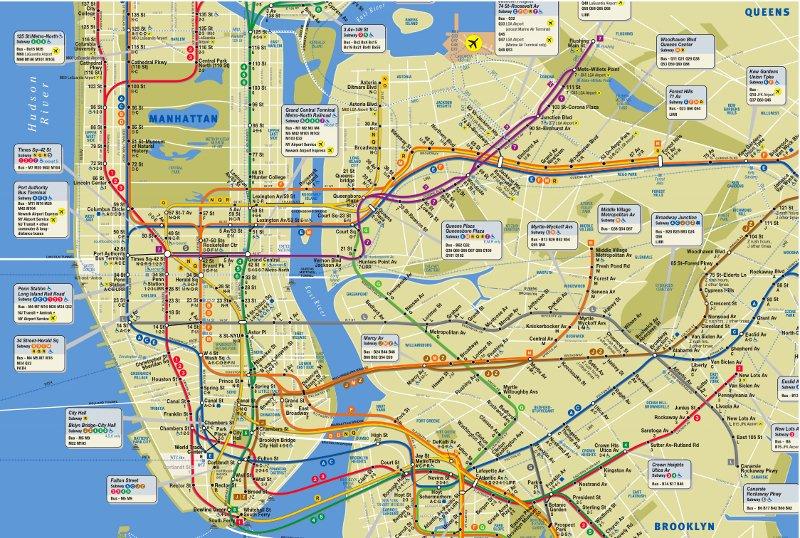New York City has been a thriving urban location that changed on, and within, its surface to provide a better commuter experience. Throughout the late 19th and 20th centuries, NYC has been growing in residence and industry, both which required greater methods of transportation. The City contained simple transportation; such as horse-drawn vehicles, cable cars, and surface trains. The introduction of electricity soon led to improvements on railroad cars and trolleys. The needs of an expanding metropolis pushed the city to develop a united system for transportation.
In the late 1880’s, NYC expanded rapidly, and established a regional management system. The city’s “center” became the most occupied region for large corporations and organized politics. The center was enclosed by popular commercial regions. Surrounding the commercial regions were the city’s diverse residential districts. Industry moved away from the city to outside rural regions. NYC sprawled a great deal and required better methods of transportation for its residents. The distinction between train transportation was important to the city. The surface train is the train track structure above the street. The subway is the train tack below the street.
In the 1890’s, there was no organized transportation under one company name. Private companies originally managed transit routes and surface lines. New York City was not managed by the mayor only, private investors and companies made improvements on their own. Private industries constructed railroad lines within, and from the city, to transport resources and products. Also, industries promoted transportation by train for their workers who lived miles away from work. Local transit was provided by private investors who placed overwhelming charges on short distances.
The City was undergoing rapid development, but there were specific issues about who was responsible for the city and its growth. Soon, the issue over the city became an issue over influence associated with politics and money.
Tammany Hall was a political machine, which controlled NYC politics through its influence with the city’s residents and immigrants. Tammany Hall worked to help people in exchange for their votes. Tammy Hall, along with other political figures, sought improvements to the city’s transportation base and acquired more political capital.
New York City’s transportation became organized and further advanced in the early 1900’s. Small railroads and industrial tracks were bought under control of well established companies. Competition between companies provided the public more transit options with affordable prices.
The Interborough Rapid Transit (IRT) Company, created in 1904, was a private operator of the underground New York City subway line. The IRT built, equipped, and operated under leases from the city. The IRT worked extensively through Manhattan and operated the numbered subway lines. Then transit expanded to the Bronx, Queens, and parts of Brooklyn. Most of the IRT lines are the underground lines that are used today.
The Brooklyn-Manhattan Transit (BMT) established two decades after the IRT. The BMT was a successor to the Brooklyn Rapid Transit (BRT) company of private investors that formed in 1896. The BRT took over the property hosting existing surface railroads and property with potential use for railroad construction. The BRT accumulated debt and reached bankruptcy during World War I and restructured itself as the BMT. The BMT rapidly built and bought elevated lines throughout Brooklyn and soon assumed control of Brooklyn’s rail transit. The BMT organized subway lines in Downtown Brooklyn along with elevated lines in Sea Beach and Brighton Beach, managing the lettered routes.
In 1913, NYC began the Dual Contracts or Dual Subway System project which involved both the IRT and BMT for collaborative work on rapid transit lines in the city. [The contracts were not really “dual” as the two companies signed agreements with the city, a third patron of the project.] The contracts allowed for building of new lines and reconstruction of existing lies. A majority of the rail lines form the contracts remain in use today.
The Independent Subway (IND) was formed by NYC in the 1920s as a “city owned, independent from other companies” subway system. The City’s Board of Transportation operated the line themselves. The new subway lines did not connect to the excising IRT and BMT lines. During the Great Depression (1930s), the two companies went into bankruptcy. The city took over the entire subway system in NYC on June 1, 1940. The legal holdings of the IRT and BMT were added to the IND. On paper the ideas were great. It gave the city control of its transit, but the unification process was expensive and took time to coordinate.
The remains of the old subway system remain active today. The trains of the BMT and IND lines were longer and wider than those of the IRT lines. Therefore, the lettered trains cannot go through all parts of the numbered train routs. This situation has been addressed over the years, but still remains a problem.
The Subway System naming has retained its original names. All the lines are classified by colors that describe the route, relevant to its location. For examples, the sunflower yellow of the N, Q, R, service is classified as the BMT Broadway Line, Broadway below Time Square. This creates some confusion as commuters in Brooklyn do not need this information.

